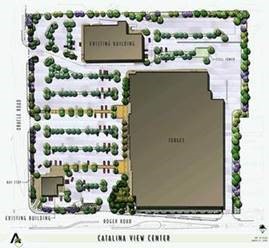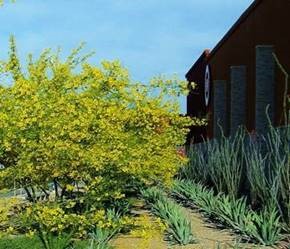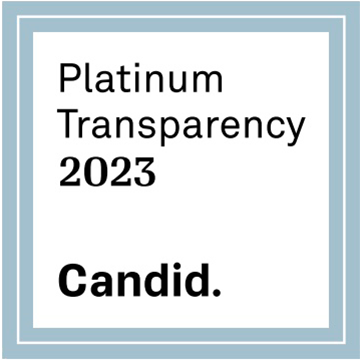Development Codes & Standards
Landscaping and screening requirements are common components in land use and development codes. They usually apply to new development common areas, parking areas, street buffers, and areas along property boundaries between adjacent land uses – rather than to single family residences on separate lots. Landscape water use can be significant, so it is imperative to incorporate conservation features and design at the time of construction. It is also critical to make sure that the width and density of buffer areas and parking lots takes into account the size of plants at maturity to avoid future maintenance problems.

The design of this Tucson Target parking lot incorporates rainwater harvesting and permeable pavement. Photo Credit: ARC Studios, Inc.
In the case of parking lots, landscaping requirements, if they exist, are generally minimal. Yet large expanses of paved parking areas increase runoff, create heat islands, increase glare, and impact the character of a community. Alternatively, parking lots can be designed to include pervious surfaces to allow water to infiltrate into the ground to replenish groundwater and to divert runoff to water landscaping and trees that provide welcome shade. To accomplish this, parking areas must be properly designed with sufficient space allotted to accommodate tree roots to ensure healthy, attractive trees that provide sufficient shade and do not interfere with parking and pedestrians. Standards should include plant selection criteria, and guidelines for proper maintenance. Developers often opt for the least cost approach when installing parking lots, but landscaping codes and standards that require sufficient numbers of trees and infiltration of runoff can turn these hot, barren places into attractive community amenities.

Native plants were used to landscape the Target parking lot in Tucson, Arizona, and make use of harvested rainwater irrigation. Photo Credit: ARC Studios, Inc
Traditional landscaping and screening codes focus on visual separation of a new use from adjacent uses and not on minimizing water use as much as possible. While codes may encourage or require use of plants from a designated list to maintain the character of the area or encourage use of low water use plants, they often do not require use of the full suite of potential water conserving features such as passive rainwater harvesting to meet plant water needs.
Water conserving features that can be incorporated into landscaping and screening codes include use of Xeriscape principles such as rainwater harvesting, grouping plants by their water needs, soil improvements to absorb and hold more water, and efficient irrigation like drip systems. In addition, codes that include a low water use plant list and protection and incorporation of native plants result in lower maintenance costs and substantial water savings if they are watered according to their actual needs.
Case Study: Sustainable Landscape Code – City of Flagstaff, Arizona
In 2011, Flagstaff modified its 1991 Land Development Code to update and modernize the Code (now a new Zoning Code), in part to promote sustainable development practices and Smart Growth principles, to ensure protection of resources and open space, and to allow for more compact development. This revision included changes to its landscaping code to “foster the creation of sustainable landscapes appropriate to the unique natural characteristics of Flagstaff …. In addition, Flagstaff has limited water resources, and consistent with the General Plan’s goal of being a steward of the natural environment, high expectations for the use and management of this precious resource have been established.”
The code applies to all new developments with the exception of a single-family dwelling and single family cluster dwelling residences in certain zones. It also applies to certain existing developments if there is a 35% increase in the number of dwelling units, parking spaces, and non-residential floor area.
The code promotes sustainable landscaping regulations that require Xeriscape landscaping and incorporation of low impact development design, and it describes 18 benefits of sustainable landscaping including the following:
- Water conservation
- Erosion and runoff protection (plants bind soil and slow runoff)
- Financial benefits (large plants add value)
- Native vegetation (drought resistant, low maintenance, high survival)
- Low Impact development (capture and infiltration of runoff close to the source)
- Stormwater management (improves water quality and increases groundwater recharge)
Selection of plant materials from an approved plant list with an “Oasis Allowance” in specific locations is required. Plants must be grouped according to “hydrozones” based on the Xeriscape principle of grouping plants by similar water use requirements. Use of greywater, reclaimed water, or harvested rainwater rather than potable water is encouraged whenever possible. In commercial and institutional zones, recreation fields and golf courses are required to use reclaimed water.
Low impact development practices are required to capture the first inch of runoff, and rain water harvesting must be integrated with development plans for irrigation purposes. The code also encourages and provides information on the benefits of preserving and using native plants, requires use of native seed mixes for detention areas, and provides some incentives for use of native plants (e.g. allows a smaller plant size requirement).
Parking areas must be landscaped depending on the number of spaces. Generally, areas with eight or more spaces are required to have 30 square feet of landscaped area per space, consisting of trees, shrubs and groundcovers. Sufficient landscaped areas in parking lots reduce heat, improve air quality and can be designed to capture water runoff, including runoff containing pollutants.
Model Code
Flagstaff Landscaping Standards found in Division 10-50.60 of the Flagstaff Zoning Code
Contact
City of Flagstaff Planning and Development Services
Website: http://www.flagstaff.az.gov/index.aspx?NID=622
Email: rcardiff@flagstaffaz.gov
Phone: 928.213.2611
Additional Resources
- The City of Tucson Landscaping and Screening Regulations contain a separate section devoted to “Use of Water.” The section requires water conserving design, use of reclaimed water, detention of stormwater runoff for landscape irrigation, restrictions on ornamental water features, and water conserving irrigation systems.
- The Town of Sahuarita, Arizona’s Landscaping, Buffering and Screening Standards can be found here.



